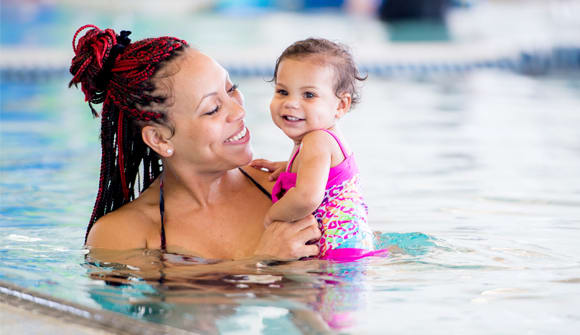Stay cool at the pool
Sun and water safety for kids.
Article Date:

Summertime means lots of poolside hangouts and outdoor time with the family. But if you have small children or grandchildren, it’s important to ensure they stay safe in the sun and while swimming, especially since drowning is the leading cause of death for children ages 1 to 4, according to the Centers for Disease Control and Prevention.
Heat safety for babies
Parents know it’s important to protect their baby’s or toddler’s skin from sunburn and long-term UV ray damage, but the temperature itself can be just as dangerous. The American Academy of Pediatrics (AAP) recommends children play indoors when temperatures reach 90 degrees Fahrenheit or higher. If you need to go out in such hot weather, kids of any age should avoid sun exposure while the sun is strongest (between 10 am and 4 pm).
Additional sun safety tips include:
- Keep babies younger than 6 months out of direct sunlight and temperatures above 90.
- Stay in the shade with your baby as much as possible. A wide-brimmed hat is also helpful for providing sun protection.
- Apply a broad-spectrum sunscreen with an SPF of at least 30 to areas of your child's body not covered by clothing, especially the face, hands, back of the neck, tips of the ears and tops of the feet.
- Apply sunscreen 30 minutes before going outside. Don't forget to reapply every two hours, sooner if your little one goes in the water, and consider using water-resistant sunscreen.
Pay attention for drowning prevention
Playing in the water together lets your baby or toddler use different muscles than they do at home, which helps build strength and coordination. Learning to swim and getting comfortable around the pool will also help them stay safe in the water as they grow. Here’s how you can prevent potential accidents:
Start slowly.
At the pool, hold your baby and dip his or her feet in the water or sit on the steps together to start. Once they’re comfortable, you can walk around in the shallow end together. Make sure your child always wears a life jacket or floatation device that is Coast Guard-approved.
Stay close.
Young children should never be left alone around water, and that doesn’t just mean pools. Teaching your child to swim is a good first step, but it doesn’t guarantee accidents or drowning won’t happen.
“Always be within arm’s reach of your child,” said Jessica Winberry, prevention coordinator with THE PLAYERS Center for Child Health at Wolfson Children’s Hospital. “Babies and toddlers are at risk for drowning in bathtubs, toilets and buckets. Parents and caregivers should take extra steps to ensure safety by emptying water from things in the child’s environment and using toilet locks.”
Focus on them.
“Safe Kids recommends assigning a ‘Water Watcher’ during any swim time. This designated adult should remain undistracted so he or she can maintain visual contact of all children in and around the pool,” Winberry said.
If there are multiple adults in your group, take turns being the “Water Watcher” in 15-minute increments. This helps whoever is on duty be fully focused for that short period of time, knowing they’ll soon swap out to socialize, eat or run to the restroom.
Create a safe setup.
If you have a pool at home, make it difficult for a child to get anywhere near it without you knowing.
“Layers of protection are an important step in drowning prevention. These include door locks, door and pool alarms, and isolation fencing,” said Winberry.
Keep your kids happy and healthy this summer
THE PLAYERS Center for Child Health at Wolfson Children's Hospital provides child injury prevention information through Safe Kids Northeast Florida.



